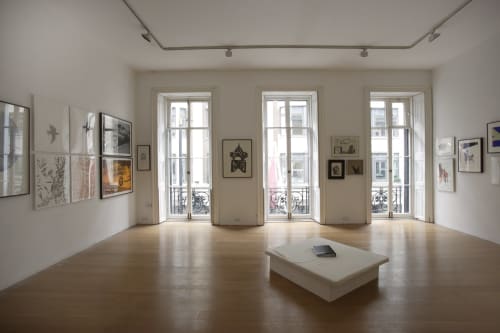COLIN SELF: Works from the 60s
Extraordinarily, this will be the first London exhibition of Colin Self's '60s work since his first solo show at the Piccadilly Gallery in 1965.
The exhibition will include drawing and sculpture exhibited at this first solo show and at the celebreated Robert Fraser Gallery in its '60s heyday. Works by Self were acquired by David Hockney and the Rolling Stone Brian Jones, amongst others. This exhibition will show a significant number of prints from the period, which reveal Self to be one of the most prolific and experimental printmakers of the decade.
Self is a significant figure in British art history (at the last count, the Tate had acquired 76 Selfs), but there have been hardly any significant solo shows, and Peter Blake has referred to Colin Self as a 'forgotten hero'.
Much has been made in recent years of Colin Self's unique contribution to British Pop Art. He was the only Brtish Pop artist to refer explicitly to the Cold War. Works depict nuclear bombers, Hiroshima victims, guard dogs on missile bases and the famous 'Nuclear Fallout Shelter' series depicting sex shop mannequins. The most potent images of the period are pervaded by a nuclear paranoia rooted in the artist's fear of nuclear war. He was born during World War Two near the American bases in Norfolk. Though he was never a political artist, the nuclear threat obsessed him to the poin that he set out to make a visual record, for example in 1000 Temporary Objects Of Our Time, in the eventuality that all of humanity would be destroyed.
Sitting in a pub in 1962 as the Cuban Missile Crisis reached its high point, he was waiting for the world to end. When peace was declared, according to the artist, his 'blocked psyche' was released and he was able to 'pour out new radical, conservative, revolutionary, post-atomic work, with possibilities, attitude and atmosphere.'
Self's drawings have been described as obsessive and neurotic. The artist himself says that his exquisite technique is 'near to sarcasm...overloving to the point of being vulgar...like a still sexually receptive widow caring for her pet dog.'
This special exhibition has been curated by Mark Glazebrook, who, as art critic of The London Magazine in the mid-1960s, was one of the first to write about Self. (As Director of the Whitechapel Art Gallery, Glazebrook later organised David Hockney's first major retrospective exhibition.)
We are publishing the first catalogue to appear on the artist's work of the 60s, a key period. It will include an essay by Mark Glazebrook placing Self in the historical context of the time.
Simultaneously, from June 21st, the artist's first museum retrospective will be shown at Pallant House Gallery, Chichester. Entitled Colin Self: Art in the Nuclear Age, it will show works from throughout the artist's career.



